So big is the baobab tree of Kasane, it once served as a prison. Later it served as a post office, though today it serves simply as a tree. This 1,500-year old behemoth is rooted in northeast Botswana, where elephants are the leading cause of car accidents.
“That is a problem for Botswana,” says Big Mike, my guide, whose meaty shoulders piledrive each time he chuckles, which is often. “There are road signs warning of animals, but where are the signs for the animals, warning of humans?”
Botswana – fractionally larger than France, but with fewer than three million inhabitants – is a slow-moving, slow-speaking landlocked nation aligning South Africa’s northern border between Namibia and Zimbabwe. Get ready to meet locals christened Gift or Givemore, Pleasure or Pedso (“The End”: for his mother swore he’d be the last), Fortune or Fortitude – an array of names as colourful as Africa itself. Even the bountiful wildlife seems as chilled out as the humans here. It’s a peaceful, welcoming and stable land of charming anomalies, chief among them being how such a granny-gear nation produces some of the fastest sprinters on the planet.
Elephants, I say. There are more here than in any other nation (130,000 and counting). Could legging it in Botswana – 100m, 200m or 400m – be more survival than sport?
At 12,000sq km, Chobe National Park doesn’t disappoint. The park is where the woodland stubble of Zambezi Teak, Jackalberry, Mopane and Marula sprouts from the ochre sands of the Kalahari, and where, within the first couple of hours, I strike leopard gold.
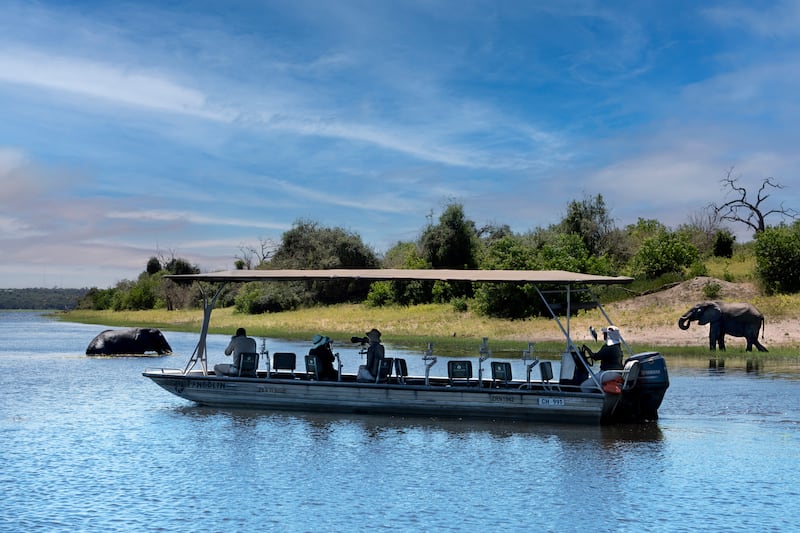
I lap up five of these speckled beauties over the coming days – between our early morning and late afternoon game drives with Big Mike – along with lions, giraffes, buffaloes, baboons, hyenas, hippos, zebras and crocodiles. And that’s only the appetiser. The country is full of wildlife, stretching down to the wide and winding Chobe river, and while the blue-sky temperatures reach more than 30 degrees, it’s a fine, high and arid heat that rarely dampens the shirt.
“If ever the hippos charge, do not jump out of the boat or the crocodiles will taste you,” we’re told, as we load on to the flat-bottomed swamp cruiser one morning, given swivel seats with pro cameras – armed with telephoto lens and a memory card to keep – mounted upon swivel stands. We get close up among the crocs and hippos and buffalo and, of course, elephants, but the excursion is a tad undermined by the number of similar tourist boats.
Another 300m or so north, the wide river floodplain is lined with the farmed cattle, residences and barking dogs of Namibia; not quite the Tarzan film set I had in mind.
We motor past a small, sleeping elephant herd, cast on their sides as if they’d fainted seconds beforehand. Such unexpected marvels are what safari is really about
We are “under canvas” in Chobe National Park, which is another way of saying we’re staying in a spacious luxurious tent, equipped with its own bathroom and attendant butler, within a staffed camp with kitchen and dining tent. And it’s here that the night sounds have to be experienced to believed. It’s not just the roaring of lions or insistent zebras, but the barking of baboons and the belches of kudu, the large woodland antelope found in these regions. It’s easy for your imagination to take over. My first night has me up late – in half-terror, half-wonder – at some gasping just metres away, before I finally realise it’s the snoring Spaniard in the next tent.
And it’s not just the night-time noises that stop you in your tracks. The following day, we motor past a small, sleeping elephant herd, cast on their sides as if they’d fainted seconds beforehand. Engine off, I shut my eyes to listen fully to these snoring giants, out for the count in the morning sun. Such unexpected marvels are what safari is really about.
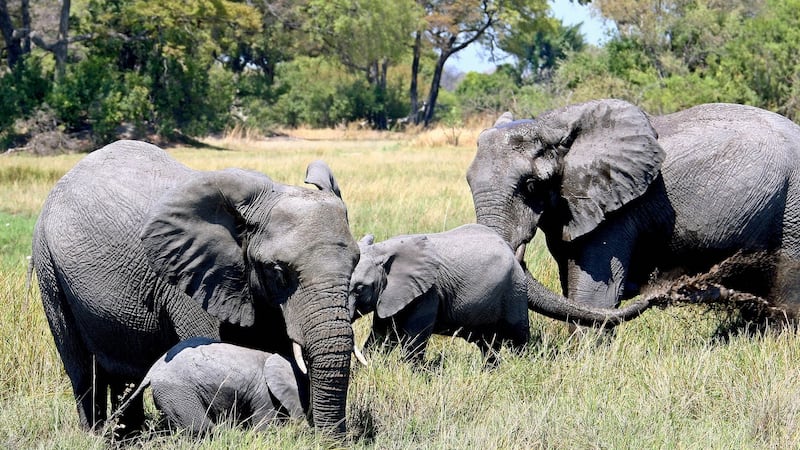
After two nights at Chobe, I fly down to an Ulster-sized inland delta in the heart of the Kalahari Desert. Much like what the duckbilled platypus once did to the neat classifications of zoology, the Okavango is a geographical, ecological and temporal freak.
Okavango’s rainy season barely makes a dent on local water levels. The actual flood season flows from June to August, when the delta swells to three times its permanent size – many months past the rainy season. This is because 80 per cent of the delta’s water comes down the Okavango river from the Angolan Highlands, 1,600km away. To complete the freak show, once the water arrives in the delta, more than 90 per cent will disappear through evaporation or transpiration.
Much like the ancient hand stencils that populate southern Africa, the Okavango resembles a mangled hand (in satellite imagery). There’s a wrist (the Okavango river coming in from the northwest), a palm (the 5000sq km permanent swamp) and the outstretched fingers (the multiple channels), which seasonally flood. In and around these channels is where the wild things are. A wealth of wildlife is drawn to the attendant floodplains, islands, savannah (replete with giant, Dali-esque termite mounds), grassland and woodland.
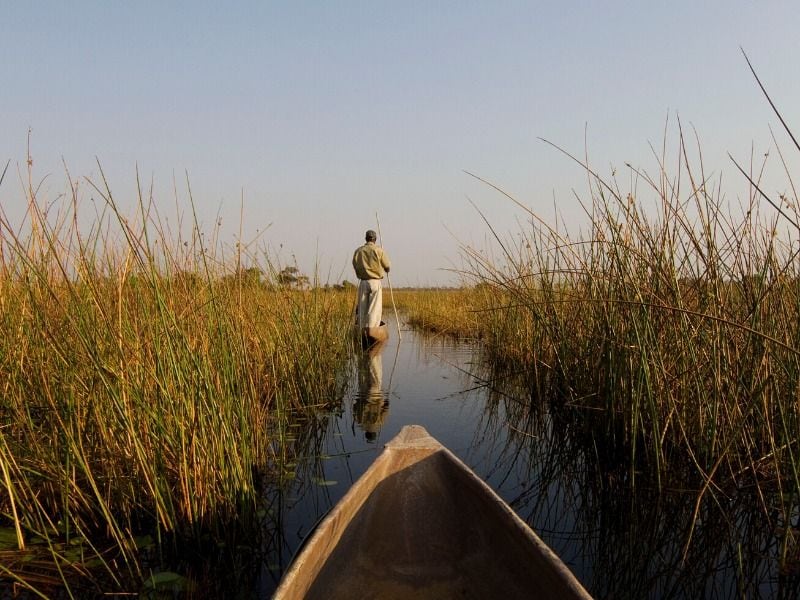
Among this confounding tapestry of papyrus, palms and water-lily lagoons sits my home for three nights. The &Beyond Sandibe Lodge is a spectacle in itself. Mimicking a giant, sleeping, shingled wood pangolin, the arcing folds of the lodge sit neatly beneath wild date palms and fig trees, thankfully raised high over the neighbouring lagoons and high-grass floodplains, where hippos mope in the petite lagoons as loner elephants wander between palms, shaking them to blazes.
Each of the 12 luxurious, elevated suites – modelled on the nest of the golden weaver bird – is a victim of its own success. So luxurious and private are they, you need to pump yourself to ever leave. My favourite quirk is stepping out stark naked each afternoon, following a sumptuous lunch that follows a morning’s fruitful safari, to descend into my own private plunge pool overlooking the floodplain. Plummeting in and out, which will I forget sooner: the waterbuck, steenbok and bushbok stamping the ground beneath, or the stunned vervet monkey faces in the branches overhead, bewildered at the brazen paleness of such Sapiens?
There’s the sublime grace of a family of leopards up close to consider, or the innate terror when a huge male lion, five metres away, turns and eyeballs you
To truly grasp the bountiful package that is the Okavango, a helicopter spin is essential. There you will see myriad lagoons and “hippo highways” in vast tracts inaccessible by foot, jeep or boat. Look! Here’s the sun glinting off the water and there’s the wan, circular mineral pans mammals lick for strength. But my favourite are the legions of hippos running back into the water as the chopper combs past, as if caught sunbathing in the nip. Or the most colossal crocs strung out along the water’s edge, as if eternal mime artists waiting for the coin to drop in the slot.
[ South Africa is a country of contrasts – stunning beauty and a lot that ranklesOpens in new window ]
Sky-bound, you finally get the picture: there’s a lot of wildlife here, only it’s segmented into bite-sized, bespoke units, owing to the seasonal channels and incongruous treelines, formed on linear banks that originally evolved from termite mounds. It means you’re not going to see thousands of wildebeest or buffalo or zebra seesawing to infinity, but you have the Serengeti for that.
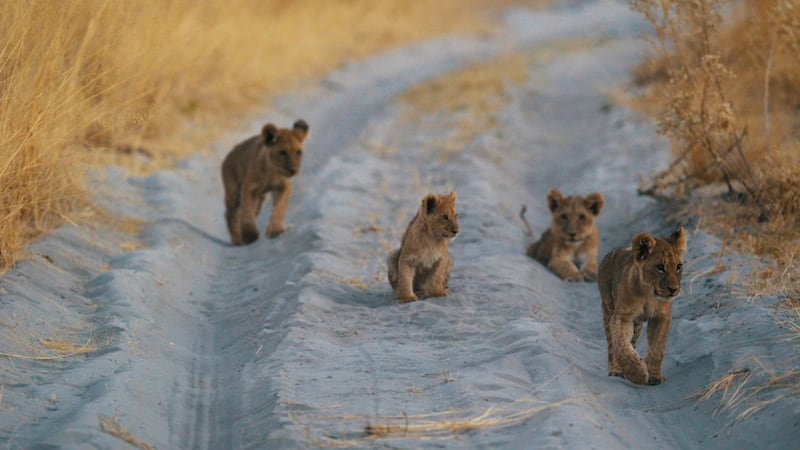
Another way to frame this mesmerising environment is via a walking safari from the lodge, with two excellent, rifle-clad guides before and behind. Here you quickly realise that you’re as vulnerable within shouting distance of the lodge as you are several miles from it. It’s not so much the predators you ought to fear, but all those bigger, heavier beasts who you can too easily startle. Step by step, the adrenaline sticks, making it all the more engaging.
Yet, when all is settled, what do I remember the most from these Okavango days? Well not the stoic African sea eagle, nor the off-looking red lechwe deer, endemic to such African wetlands. Perhaps the pet-puppy-toy squeaks of the wild dogs or the titters of the hyena? The regal saunter of a journey of giraffes?
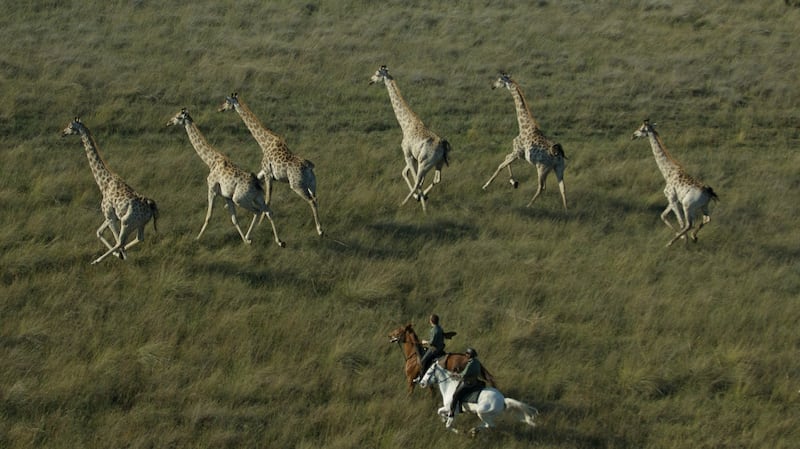
Then there’s the sublime grace of a family of leopards up close to consider, or the innate terror when a huge male lion, resting five metres away, turns and eyeballs you. As he leaps to his feet and marches towards you, you feel the lining of your gut instinctively drop an octave lower, while he circles the jeep and carries on walking. It’s then you ask yourself: when did I last feel this alive?
Jamie Ball was a guest of &Beyond, with flight support from Adams & Butler a Dublin-based luxury travel agency.
Getting there
Unlike a Kenyan or South African safari, getting to the landlocked, less-populous Botswana is a messier, more expensive, long-haul trip from Ireland. The most palatable means for me was to overnight at Johannesburg’s OR Tambo International Airport and fly on the following morning to Kasane, in northeast Botswana – a flight of less than two hours, and which showcases otherworldly views across the Kalahari.
In all, it took about 15 hours to fly Dublin-Johannesburg. Broken down, it meant first flying to Heathrow, then to Johannesburg on an overnight flight to arrive at breakfast time in South Africa. Shop around on skyscanner.ie and, if booking several months in advance, you should be able to land return flights for in or around the €700 mark.
While not cheap, I stayed at the Intercontinental Ortia Hotel at OR Tambo in Johannesburg, as it’s less than 100m from the terminal and, more importantly, a safe haven on the outskirts of the city, where I’d spent a week during 2016 and very much warmed to, but it’s certainly not renowned for safety.
A single night at this five-star hotel will, unsurprisingly, set you back at least €260, but there are, of course, far cheaper – and thoroughly decent – hotels in and around Johannesburg to choose from. That said, the return leg didn’t need any such overnight stopover, so it all depends on your flight dates.


















